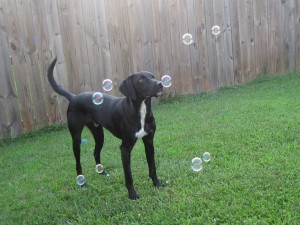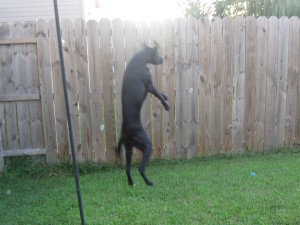My dog got heat stroke this past weekend. It was scary, especially since I thought I was being careful enough to avoid that situation. Fortunately since I knew what to look for I caught it early and it had a happy ending. I thought I’d share my experience so you can see just how quickly it can happen and what to watch out for.
Plato is a fun-loving 1 ½ year old lab/pointer mix. He LOVES to run, and one of his favorite activities is running laps in our back yard, popping bubbles with my 3 year old son, Drew.
That’s exactly what we were doing Saturday morning, and I thought it would be good for him since he had spent the majority of the previous day cooped up in his kennel. Saturday was warm and humid, but we were only outside playing for about an hour and were back inside by 10:15. The temperature was still in the lower 80’s (It’s mid-July, and not the first time it’s been this warm), and Plato had even come in and out of the air-conditioned house a few times in that time frame.
We had been inside for 5 or 10 minutes, I was reading a magazine to Drew and snuggling with Abby (my 5 month old). Plato was panting, nothing concerning. Then, out of the blue he vomited all of his breakfast. We sent him outside to finish vomiting while we cleaned it up. When we got him back in a few minutes later he was really dragging. I honestly thought he had eaten something in the yard that didn’t sit well. He curled up in his bed for a while, and when I checked on him a few minutes later he was still panting. That was when the red flashing lights went off in my head. He should NOT still be panting after being inside and laying down for 10 minutes.
I took him outside again and sprayed him down with the garden hose. I got out a rectal thermometer that I keep just for my pets to confirm my suspicions. A normal temperature in a dog or cat is anywhere from 100.0 to 102.5. Plato’s temperature was 105.6. He had heat stroke. That term that’s associated with negligence. I couldn’t believe it.
I carried my 50 lb dog up the stairs and put him in the bathtub. He’s not a fan of water, and the fact that he willingly laid in the tub while I filled it with water only underscored how crappy he was feeling. I filled the tub with cool (NOT cold) water. Drew was spraying him with the detachable shower head because, well, he really wanted to help and needed a job. When I checked his temperature a few minutes later, it hadn’t budged. Time for more invasive measures.
I got him to the vet clinic and grabbed Ali to help me. We placed a catheter and got some IV fluids going to cool him off, and put him in a kennel with a fan on him. Within a half hour his temp was down to 102.3, and in an hour he was completely back to normal, albeit worn out.
This story had a happy ending because it was caught early and treated right away. It could have gone a whole different direction if we had had to go somewhere and left him home alone in his kennel, or if we had dawdled around trying to treat him at home.
Heat stroke happens when an animal’s thermoregulatory system can’t keep up with the heat, meaning that although they are panting, their body temperature keeps going up. This can happen when a dog exercises excessively in heat, particularly humid heat. It also happens when pets are left outside in the heat or in a hot car. Older animals, obese animals, animals with respiratory diseases, and those with short noses (pugs, bulldogs, etc) are more prone to heat stroke because they have a harder time cooling off with panting.
Normally when a pet starts getting warm, the blood vessels close to the skin dilate. As the blood goes through those vessels it is cooled, and will help cool off the rest of the body as it travels back to the heart. However, if the body gets too warm their blood starts collecting in the abdominal organs (so not going to the skin vessels), the pet loses the ability to cool through those skin vessels and temperature keeps going up. If the situation is not corrected, death comes quickly.
Early signs of heat stroke such as Plato demonstrated include vomiting, lethargy, and panting. You could also see diarrhea, increased heart rate and respiratory rate, bounding pulses, and dark red or muddy brown colored gums. As it gets worse pets start to have difficulty breathing, pale gums, and weak pulses. Eventually pets can seizure, go into a coma, and die.
If you think your pet may be overheated, start the cooling process immediately. Get your pet into air conditioning and/or put a fan on him. Cooling off with a garden hose or bath is great. You want room temperature to slightly cool water. NOT cold water, and NEVER USE ICE WATER!







